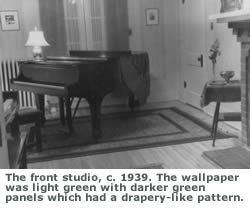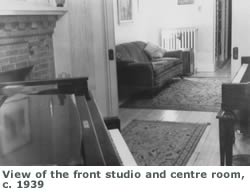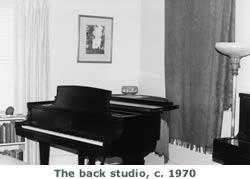Studio History Notes

The Studios were the real hub of Lyell Gustin's musical activities. It was here he taught for many hours each day and where nearly all his students' performances began. When students and friends of Lyell Gustin entered the Studios it was if they entered a different world. It was an atmosphere which Mr. Gustin created not only to provide the proper surroundings for wide-ranging musical activities for his students but also a place where their interest in all the arts and literature would be encouraged. Besides books on music, his library included volumes of art reproductions, poetry, plays, novels and essays. The Studios were tastefully decorated with paintings, pictures and art objects which reflected Mr. Gustin's cultured, gracious spirit. Even the furniture, most of which dates back to the 1920's, gave an orderly, elegant look to the Studios..
One cannot adequately describe the impact such a house had on students. Some came from backgrounds conducive to learning in the arts and literature while others had no such background; yet, when all stepped into the house, they entered a place such as they had never seen before and they left imbued with ideals of excellence in all the arts as Mr. Gustin espoused. To many students, not only those who were studying music full-time, but also those who were studying while attending high school or university, the Studios were a focal point of their musical and social life. Interpretation Classes, Soirees, ensemble rehearsals, special programs and social events were all part of the activities in which students participated. From 9'o'clock morning lessons to late night ensemble rehearsals, the Studios were a hive of musical activity for six, sometimes seven, days a week. No wonder, then, that some of the students considered their association with the Studios the most influential period in forming their professional careers and their cultural interests.
Mr. Gustin was unstinting in giving of his time, knowledge, experience and friendship to students. Few individuals would have devoted such a major part of their life to their students' musical and artistic development as did Mr. Gustin.
At the top of the list of activities were the Interpretation Classes, held on the second Wednesday evening of each month from October to March or April. At these classes senior and graduate students performed those pieces which were ready for public listening and if a student were preparing for an examination, festival or recital, one was expected to be ready to perform. All students interested in furthering their pianistic and musical studies would attend so that from the back studio to the front, the house would be filled to capacity, with perhaps 50 or more people--standing room only. During a year many major works would be performed. There would usually be an intermission after which the more advanced student/artists would perform works from the concert repertoire.
It might be noted that on two different occasions, marking special anniversaries, the entire year's Interpretation Classes were given over to performance of the complete piano compositions of Frederick Chopin. At other times special programmes would be given of such sets of compositions as the Debussy Preludes, the Fantasiestucke of Schumann or the Tombeau de Couperin of Ravel with various pieces being played by different students. Other programmes would emphasize the works of a particular composer, a period of music or have pieces from the general piano repertoire. One can imagine the invaluable pianistic education students were getting through events of this kind, and this in a city thousands of miles removed from the great music centres in Canada and the United States. At the conclusion of the programme there would be a light lunch and coffee, the social mingling of students being of great importance to Mr. Gustin. After this there would be less formal music-making where students would perform pieces from their repertoire, perhaps for the second, third or fourth time, simply to gain experience in performing them. The audience was now those who chose to stay back after others had gone home and this part of the evening often went past midnight. Perhaps it was in these hours, when performance nerves were gone and when spontaneous laughter and joy of experiencing the company of kindred souls took place, that the spirit of the man and his Studios was unconsciously absorbed.

Lyell Gustin also directed his students into awareness of the other arts. He had a large library of books which were not only on musical subjects but also included classic novels, poetry and books on art. He was always interested in drama and he had a unique way of stimulating his students' interest into this area. On the fourth Wednesday evening of each month he held Soirees. A bit less formal then the Interpretation Classes but still maintaining a certain decorum, these evenings were given over to the reading of plays. One student would be the director and other students would be given roles to prepare, the Sunday previous being rehearsal evening. Then, before a smaller group than appeared at the Interpretation Classes, but a group which was probably made up of those seriously interested in things artistic, the play would be read. By this means students became acquainted with the great dramatic works of Shakespeare, Ibsen, Barrie, Shaw, Eugene O'Neill, Tennessee Williams or other playwrights. Sometimes the latest Broadway or London hit would be read.

After the reading, there would be a social hour and again, piano music would be part of the evening's events. This music often took the form of duet arrangements of the symphonies of Haydn, Mozart, Beethoven, Brahms, Tchaikowsky and others. The duet arrangements were doubled by two players at the second so there would be four performers involved thus providing a greater volume of sound as required by orchestral compositions. These performances of the symphonies were of particular merit in earlier years when there was no Saskatoon Symphony Orchestra and when recordings were not a common or visible means of access to symphonic music. Even in later periods when there was greater access to music by these means, performances of piano arrangements of symphonies was still a good method of becoming acquainted with symphonic masterpieces. As many composers had first presented their newest symphonic composition arranged for piano, piano duet or two pianos, these performances at the Soirees were similar to the very first hearing of the works. The Two and Three-part Inventions of Bach, of which every music student and piano teacher must have a thorough knowledge, were also performed in this way. Students' artistic interests were further stimulated when local artists or academics in the arts or literature were invited to talk about their field of learning. Among these were painters Ernest Lindner and Robert Hurley, and university professors Gordon Snelgrove, Carlyle King, or J. Bentley. One had to experience a Soiree to know the enthusiasm that was engendered in the students when Lindner or Hurley brought some of their latest paintings, spread them around the rooms, and then talked about their work. The same excitement was in the air when Mr. Gustin or students who had travelled to Chicago or New York told of their journey, possibly having heard the play which had just been read that evening and wanting to share their experience with students who had not been able to make the trip.
—text adapted from Lloyd Rodwell, 1990

